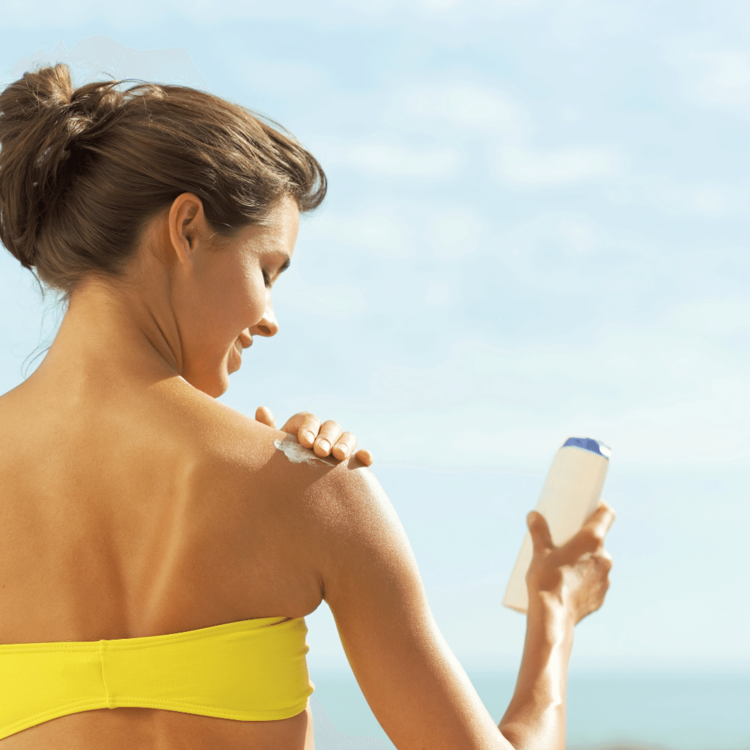
While we like to think that the lotions and serums we apply to our skin simply stay there and do as they're told, that's not always the case.

While the skin is a pretty good barrier between us and the world, some substances do manage to get past it and into our bloodstream.
That's why nicotine patches work, for example. But when chemicals, such as the active ingredients in sunscreens, wind up in our blood unintentionally, it may be a cause for concern.
Why should we be worried? Aren't sunscreens good for us, what with the way they protect our skin from harmful UV rays?
Well, the problem is that the FDA has not properly assessed whether the active ingredients used in most chemical sunscreens — oxybenzone, avobenzone, octocrylene, and ecamsule — are safe for us. That's because the agency assumed that we actually weren't absorbing it in any significant amounts, that is until a study published in May 2019.
How Skin Absorption Works
Let's back up for a minute and discuss how these chemicals are getting in. The outer barrier of the skin, called the stratum corneum, isn't exactly a layer of plastic wrap. It's made up of stacked dead skin cells called corneocytes, with lipid cells (fats) filling in the cracks between them like mortar. Poking through that stratum corneum are hair follicles.

Substances can get through the barrier in three different ways:
1) Through the lipids (the intercellular lipid pathway), if the substance dissolves in fat and the molecules are small enough.
2) Through the corneocytes (transcellular permeation), if the substance dissolves in water and the molecules are small enough.
3) Through the hair follicles (what we commonly call the pores).
Once the chemical gets past that barrier, it can then reach the blood vessels in the dermis and on to the rest of our body.
Sunscreen Ingredients: What We've Learned
Before this year, there had been some evidence that ingredients like oxybenzone could enter the bloodstream. But there still wasn't enough data for anyone to ring the alarms. Sunscreens had all slipped past regulatory requirements up until now.

But then in 2014, Congress passed the Sunscreen Innovation Act in order to facilitate the approval of new active ingredients in sunscreen, and in 2019 a new rule will go into effect categorizing sunscreen ingredients as "generally regarded as safe and effective" (GRASE) or not GRASE. There is insufficient evidence to say whether four of the most common chemical sunscreen ingredients are GRASE or not.
The Latest Sunscreen Research Explained
The FDA decided to conduct this study in order to determine whether further testing of those chemicals is really necessary. If people don't absorb more than .5 ng/mL in their blood after typical use of the product, then the ingredients could continue to go under the radar.
For the study, 24 people of varying skin tones and ages were randomly assigned to use one of four common sunscreens: two sprays, one lotion, and one cream. Like most chemical sunscreens on the market, the sprays and lotion contained oxybenzone, avobenzone and octocrylene, and the cream contained avobenzone, octocrylene and ecamsule.

The subjects were directed to use the products four times a day, applying it to 75% of their body, for four days, because that would be the recommended usage if they were, say, away at the beach for a long weekend.
They had their blood tested 30 times (yikes!) over the course of seven days, beginning on the morning before they started using the lotion and ending three days afterward.
The results were pretty darn conclusive: By day one, all participants had blood levels over .5 ng/mL for every active ingredient in their given sunscreen. Most reached the threshold within two hours for oxybenzone, and within six hours for avobenzone. Their levels increased with each day of use (reaching as high as 209.6 ng/mL for the oxybenzone). In the case of all but the ecamsule, the chemicals remained in the subjects’ blood above that threshold for days after they stopped using it.
So by now, you might have run to your bathroom cabinet, looked at the ingredients on the various bottles, and tossed them in horror. That's not what the study's authors and every dermatologist who has read this study are recommending just yet. All this study really concludes is that more studies need to be done. For now, we just don't know whether these chemicals are dangerous.


Physical Sunscreen to the Rescue
What you definitely shouldn't do is stop using sunscreen altogether. Science is pretty clear about the fact that UVA and UVB rays from the sun can cause skin cancer as well as all those unpleasant signs of aging.
Right now, your safest bet is to use a sunscreen with an ingredient that the FDA has already determined is GRASE: titanium dioxide and zinc oxide.

These are what we call physical or mineral sunscreen ingredients, because they sit atop the skin and block out the sun's rays. You can buy these in the store or directly from us the next time you stop by. You can also protect yourself by seeking shade whenever possible, along with wearing sunglasses and hats.
We're all eager to see what the scientists will discover about those chemical ingredients. Maybe we'll be pleasantly surprised to find that they're safe after all!
Concerned about the damage the sun may have done to you this summer? Why not schedule a consultation with us now? We can’t wait to meet you.

